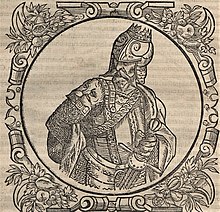25:
17:
120:, capital of Lithuania, was mentioned in written sources for the first time. Therefore, 1323 is considered to be the official founding year of Vilnius. Gediminas is considered to be the city's founder even though the city existed years before Gediminas' reign. Also, Vilnius is unambiguously mentioned as the capital city.
104:. Gediminas explained that the Grand Duchy of Lithuania was very tolerant to the Christians, but remained pagan and did not accept Christianity only because of brutal Teutonic Knights. He told about the first letter sent to the pope and his intentions to baptize in the Catholic rite. Gediminas invited knights,
151:
The fourth and the fifth letters were also written on May 26, 1323 and were addressed to the
Franciscan and Dominican Orders. Gediminas, in anticipation of his baptism, invited priests and friars to come to the Grand Duchy of Lithuania. He also asked to spread the word to craftspeople that they were
76:
friars asking for two brothers who could come to the Grand Duchy of
Lithuania to look after a local church. When the Teutonic Knights learned about the letter, they sent their army and destroyed the church. In the last sentence Gediminas vaguely promised to accept Christianity and obey the pope.
139:
cities was written on May 26, 1323. In essence it repeated the second letter. It asked for various craftspeople (the list of crafts was expanded) to come to
Lithuania and practice their trade. It said that there were three churches in the duchy: two Franciscan (in Vilnius and in
116:, millers, and others to come to the Grand Duchy and practice their trade and faith without any restrictions. The peasants were promised tax exemption for ten years. The merchants were also exempt from any tariffs or taxes. This letter is best known because
167:. It reported that the Teutonic Knights violated a peace treaty signed earlier. The Knights attacked border regions, killed residents, and took all valuables. Many messengers were captured and killed. Gediminas asked for help enforcing the treaty.
67:
did not act in the interest of the
Catholic faith. Instead, they brutally devastated the land. The people were forced into resistance. Gediminas enumerated many crimes and damages done by the knights; for example, he claimed that his predecessor
24:
182:, full-text versions, Lithuanian Classical Literature Anthology, Institute of Lithuanian Scientific Society. Accessed June 24, 2006.
152:
welcome in
Lithuania. In the letter to the Dominicans, Gediminas mentioned that his seal was burned by the Teutonic Knights.
221:
197:
226:
52:. Since they were sent to Western Europe, the Pope, merchants, and craftspeople, they were written in
49:
231:
155:
The last surviving letter was written on
September 22, 1324 and was addressed to the bishop of
113:
8:
205:
193:
190:
Chartularium
Lithuaniae res gestas magni ducis Gedeminne illustrans. Gedimino laiškai
101:
64:
145:
60:
215:
179:
80:
The second letter was written on
January 25, 1323 to the German cities of
85:
28:
Transcript of
Gediminas' letter, which is the oldest known mentioning of
141:
128:
109:
73:
93:
45:
29:
81:
16:
48:. These letters are one of the first surviving documents from the
160:
136:
124:
117:
97:
69:
33:
132:
105:
89:
156:
53:
164:
206:
Codex diplomaticus
Lithuaniæ (1253–1433), ed. E. Raczynski
213:
108:, merchants, doctors, smiths, wheelwrights,
208:, Gediminas' Letters in original Latin p 25
23:
15:
180:Gedimino laiškai (Letters of Gediminas)
214:
123:The third letter addressed to Lübeck,
40:There are 6 surviving transcripts of
36:in written sources (25 January 1323)
44:written in 1323–1324 by Grand Duke
13:
20:Gediminas, Grand Duke of Lithuania
14:
243:
148:. Everyone was free to use them.
59:The first letter was written to
1:
170:
63:. Gediminas claimed that the
7:
10:
248:
222:14th century in Lithuania
100:and other cities in the
50:Grand Duchy of Lithuania
37:
21:
163:land, and Council of
72:sent a letter to the
27:
19:
42:letters of Gediminas
227:History of Vilnius
159:, Erzel, ruler of
38:
22:
102:Holy Roman Empire
239:
204:
187:
178:
65:Teutonic Knights
247:
246:
242:
241:
240:
238:
237:
236:
212:
211:
202:
185:
177:(in Lithuanian)
176:
173:
12:
11:
5:
245:
235:
234:
232:1323 in Europe
229:
224:
210:
209:
200:
188:S. C. Rowell.
183:
172:
169:
61:Pope John XXII
9:
6:
4:
3:
2:
244:
233:
230:
228:
225:
223:
220:
219:
217:
207:
201:
199:
198:5-415-01700-3
195:
191:
184:
181:
175:
174:
168:
166:
162:
158:
153:
149:
147:
143:
138:
134:
130:
126:
121:
119:
115:
111:
107:
103:
99:
95:
91:
87:
83:
78:
75:
71:
66:
62:
57:
55:
51:
47:
43:
35:
31:
26:
18:
189:
154:
150:
122:
79:
58:
41:
39:
216:Categories
203:(in Latin)
186:(in Latin)
171:References
144:) and one
142:Navahradak
129:Greifswald
74:Franciscan
30:Lithuanian
146:Dominican
94:Magdeburg
46:Gediminas
127:, Sund,
114:skinners
110:cobblers
32:capital
161:Tallinn
137:Gotland
125:Rostock
118:Vilnius
106:squires
98:Cologne
70:Vytenis
34:Vilnius
196:
133:Stetin
90:Bremen
82:Lübeck
157:Tartu
54:Latin
194:ISBN
165:Riga
86:Sund
218::
192:.
135:,
131:,
112:,
96:,
92:,
88:,
84:,
56:.
Text is available under the Creative Commons Attribution-ShareAlike License. Additional terms may apply.

